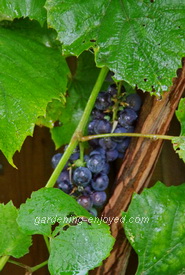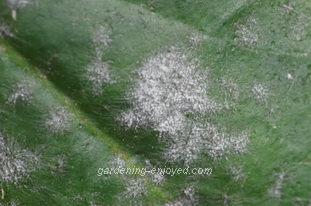| Back to Back Issues Page |
 |
|
Dallying In The Dirt, Issue #140 ---Powdery Mildew in it's many forms is an unwelcome fall visitor September 07, 2013 |

Sometimes we put a lot of effort into learning new techniques. We are delighted when the new things grow as we hoped they might. What do we then do, when that beautifully grown crop turns out to be something that we don’t actually like. If you are a regular reader of Dallying In The Dirt, you will have followed my learning curve as I planted, trained and learned to properly prune my new Grape vines. I had a great crop of Grapes and I even was able to harvest them before any other creatures helped themselves. I don’t like them! They are somewhat bitter and they have a plentiful supply of seeds that are difficult to dislodge as you are eating them. I’m sure they would make a great grape jelly but how much of that can you use in any given year. Much to my great dismay, my carefully pruned 6 row kniffen is going to be ripped out. I’ll take out one this year and plant some better variety in the spring. I wouldn’t want all that learning to go to waste. When the new variety is established, I will rip out the second vine and replace it. Live and learn as they say.  Another wonderful story from my recent trip to Quebec City. My Garden Writer’s group always has an early morning trip for the avid photographers. This year we were taken to a magical garden that is now on my list of places that must be seen again. Domaine Joly De Lotbiniere exceeded our expectations in many ways. The property was held by the Joly and Lotbiniere families from 1672 until 1967 and they were ardent pursuers of horticultural and forestry research and development. It is now operated as a public garden by a non profit organization. The early morning light slanting through the trees, ferns and pathways of the shade garden were truly something wonderful to experience. I admit to being a bit jaded, having seen a few gardens over the years but this delight on the banks of the St Lawrence river grabbed my attention and made me wish that the bus would never come to take us away. If you are ever heading east from Montreal to Quebec City, find the village of Ste Croix and there, find this rare gardening gem. You won’t be disappointed.
Another wonderful story from my recent trip to Quebec City. My Garden Writer’s group always has an early morning trip for the avid photographers. This year we were taken to a magical garden that is now on my list of places that must be seen again. Domaine Joly De Lotbiniere exceeded our expectations in many ways. The property was held by the Joly and Lotbiniere families from 1672 until 1967 and they were ardent pursuers of horticultural and forestry research and development. It is now operated as a public garden by a non profit organization. The early morning light slanting through the trees, ferns and pathways of the shade garden were truly something wonderful to experience. I admit to being a bit jaded, having seen a few gardens over the years but this delight on the banks of the St Lawrence river grabbed my attention and made me wish that the bus would never come to take us away. If you are ever heading east from Montreal to Quebec City, find the village of Ste Croix and there, find this rare gardening gem. You won’t be disappointed.Time to answer a few questions. If you have a gardening question just ‘reply’ to this newsletter and send me your query. I try to answer most of the questions and the ones that I answer here are those that I think will have the widest interest. You can also find the latest garden updates on the front page of gardening-enjoyed.com. I try to change it every few days so check back often. Itzik Asks? I really enjoyed your presentation last night in Tillsonburg. Thank you for sharing your time and experience with us. Unfortunately I didn't have my notebook with me to scribble down some of your advice, so a couple quick questions to juggle my memory. What was the name of the crocus looking fall flower, that wasn't a crocus and had 6 stamen? Lastly, you sprinkled bone meal in each hole you dug for your bulbs, can I just sprinkle bone meal on top of the soil to deter the squirrels ? Ken Answers! Colchicum is the large flowering fall bulb with the 6 stamens. You were obviously paying attention :-) I actually use blood and bone meal rather than just bone meal. It has more odour and putting it in the bottom of the hole utilizes it as a fertilizer for the bulbs as well as a squirrel deterrent. Spread on the surface should work but the fertilizer value will take longer to get to the bulbs but that's not necessarily a bad thing. Kathleen Asks? I have struggled to keep primrose growing in my garden this summer because of the hot, dry conditions. Now that it is cooler the plants are beginning to flower again however there is something eating the leaves. I had the same problem last year, thought it was slugs but did not catch any in my "beer trays". Any ideas on what to use to get my primrose healthy again? Ken Answers! Slugs are the most likely culprit but there may be other suspects. Try spreading diatomaceous earth under the leaves of the primroses. It's a great slug deterrent. I’ve just discovered that slugs will actually eat the white fluff of Powdery Mildew so I guess they aren’t all bad. Yvonne Asks? My hanging tuberous begonia also has powdery mildew.?? In past years (they didn't have powdery mildew) I would wait until the frost killed the leaves, then would dry the tubers, bring them in for the winter and replant again in the spring...very successfully!.....they are looking rather unsightly right now....do I have to wait for a frost to kill it to bring the tubers in, or can I cut off the leaves, dry the tubers and bring them in now? Ken Answers! Make sure you follow the link above to the new page on Powdery Mildew. It shows up some years very early and some years not at all. If the mildew has been severe, cutting back the Begonias and storing the tubers earlier than usual can be a good practice. I would throw the cut off portions into the municipal compost rather than my own compost piles in an attempt to slow the arrival of the mildew next year. 111 Trent St. W. Whitby ON L1N1L9 |
| Back to Back Issues Page |
 Running rampant through my garden at this time of year is a very common disease.
Running rampant through my garden at this time of year is a very common disease.